IN THE SUMMER of 1986, on the verge of fourteen, I accompanied my friend and her family to the Outer Banks of North Carolina for a two-week beach vacation. The small cottage we stayed in was without a television, and after just two initial days of sunshine, a unrelenting rain came in. At first, we busied ourselves with chocolate milkshakes and gossip, several successful trips to the hermit crab store, and stuffing our first bikini tops with potholders. But eventually, her exasperated mother dropped us off at a local movie theater, where, unsure of what to see, we ordered two large buckets of popcorn, bought tickets to a movie called Top Gun, and settled in for what we were sure was a “guys’ movie.”
One hundred and ten minutes later, we staggered out into the sunlight, slackjawed and stunned. Barely able to form a complete sentence, I asked my friend’s mother to take us to a record store, where we discovered the movie’s soundtrack had yet to be released on cassette, so I bought it on vinyl. Never mind the cottage had no record player, I was made content by obsessively reading the liner notes and pressing the album to my undeveloped breast while I sobbed.

The Top Gun album sleeve makes a decent pillow, but an uncomfortable pair of underwear. Don’t ask how I know this.
In the ten days that followed, my friend and I saw Top Gun five more times. Then I returned home and saw it another five. Then it came out on VHS and I bought it. If you want to know the name of the film’s Production Designer (John F. DeCuir, Jr.) or Executive Producer (Bill Badalato) or Director of Photography (Jeffrey Kimball), I have that memorized for your convenience. What’s the movie’s barely-noticeable opening line? “Good morning, Scott.” Also. Did you know that the infamous sex scene had to be re-shot? The producers won’t tell you why, but I will: I feel confident it had to do with a thick, very un-sexy strand of saliva that reached from Tom Cruise’s lower lip to Kelly McGillis’s upper. My friend and I saw this in one of the early viewings before it was recalled. Then we noticed it was gone. Anyway, all told, I’ve probably seen the movie 82 times. But seeing that I’m almost 42, I’m ashamed that number isn’t higher. Of all the firsts I’ve experienced in my life, my initial viewing of Top Gun is near the top of the list. Almost even with the birth of my sons, but way way above losing my virginity and trying sriracha.
I’ve thought a lot about what makes this movie so successful. Renowned screenwriting classes claim it is the quintessential script—with spot-on conflict and dialogue and tension and sex, all happening at perfect junctures. Some maintain it’s just a classic 1980s Cold War/Reagan-era movie, heavy on the capitalism-versus-communism theme, that leaves viewers feeling free and invincible. Still others profess it’s the first blockbuster movie that tackled homosexuality. That it’s all about coming out of the closet, told in a way only the Navy can.
But valid theories, hot guys, and catchy music aside, I think this movie stands the test of time because it tells the oldest story there is. The epic one that history likes to tell again and again. The one told in The Wizard of Oz, in Star Wars, in The Odyssey, in The Hobbit, in religious texts the world over…that of The Hero’s Journey.
The mythologist and professor Joseph Campbell spent much of his life teaching the concept of the “monomyth”—the idea that all mythical narratives of yore tell the tale of a hero’s quest for meaning, a single narrative of the human condition. Curious as to how Campbell’s seventeen stages of monomyth might sync up with Top Gun, I sat down recently to watch it for the eighty-second time. Almost instantly, the scenes fell into the stages Campbell describes as essential steps in the pilgrimage. The symbolism popped off the screen. Suddenly, the pilots’ call signs weren’t just studly nicknames, they were representative of lore and legend. It was a whole new way to see the film. For a Top Gun nutjob like myself, connecting these dots was hardly a daunting or obsessive task, it was really “just a walk in the park, Kasansky.” But I can see how some might want me committed.
Below, I give you the movie as monomyth. If you like Top Gun, you’ll probably enjoy this. If you don’t like Top Gun, then I’m sorry to hear you’re ill. And if you’ve never seen Top Gun? Well, I’m assuming you just woke up from your coma yesterday.
~
The 17 Stages of the Monomyth
1. The Call to Adventure
According to Joseph Campbell, the first stage of the hero’s journey is The Call to Adventure, where “the hero can go forth of his own volition, as did Theseus…be carried or sent abroad by some benign or malignant agent, as was Odysseus…or begin as mere blunder.” Most action movies begin as such, and Top Gun is no exception. After the opening credits dissipate, things start off not unlike the universe did, with a big Bruckheimer bang—every electric guitar riff, synthesized drum beat, and smoky outline of aircraft carrier crewman sets the tone for an epic intro, complete with communist infiltrators, cigar chomping, profanity in spades, and lots of titanium-clad machismo.
In Maverick’s case, his clarion call to duty—the transfer to Top Gun—is brought about by the resignation of fellow pilot, Cougar, who turns in his wings after a terrifying showdown with a Russian MiG. The first twelve minutes of Top Gun almost serve as their own small film, complete with conflict, climax, and happy ending. It’s no coincidence that Cougar (seen by some Native American cultures as a messenger of the gods) and his co-pilot Merlin (the magician), work as an alchemic duo to bring about this opportunity of personal growth for our wet-behind-the-ears hero, Maverick. Never mind that he’d rather flip the bird at his demons than face his own evolution, or that’s he clueless about what awaits, at least he’s not “flying a cargo plane full of rubber dog shit out of Hong Kong.”
2. Refusal of the Call
After Maverick makes his cocky way to Fightertown, U.S.A.—and meets the cast and crew of his pending metamorphosis—he’s faced with his first assigned hop, or Top Gun flight exercise, where he employs all sorts of fancy flying and gutsy moves to “kill” his instructor, Jester. To achieve this, he flies below the hard deck, breaking “a major rule of engagement” and then doubles down on his mischief “with a circus stunt fly-by” of the control tower.
These antics are in direct conflict with what he’s been called to do—a blatant refusal of his mission. Campbell explains, “Often when the call is given, the future hero first refuses to heed it. This may be from a sense of duty or obligation, fear, insecurity, [or] a sense of inadequacy….” For Maverick, it’s an unwillingness to mature, to quit clowning around. Instinctively, he knows if he wants to advance he must kill “Jester,” who represents his inner fool. But he’s not yet ready to do so. Unless he can cheat.
To sum up Maverick’s refusal of the call as only Viper so eloquently could: “Gentlemen. You had a hell of a first day.”
(Side note fun: This scene concludes with a locker room confrontation where rival Iceman accuses Maverick of being “everyone’s problem,” “unsafe,” and “dangerous,” before snapping his teeth together in one of cinema’s most memorable moments in dentistry. I think it’s safe to say that Val Kilmer’s character represents Death, just as Eugene O’Neill’s character-of-the-same-name does in his play “The Iceman Cometh.” So, when Iceman gnashes his pearly whites at our hero, it is effectively the Grim Reaper’s way of saying “Bite me.” You’ll notice throughout the film several close-ups of Maverick and Iceman nearly nose-to-nose. That’s Maverick repeatedly facing his own mortality. What fun!)
3. Supernatural Aid
In this stage the hero, either reluctantly or enthusiastically, commits to the quest at hand, and fate responds by providing some sort of supernatural assistance. In Top Gun, this is played out when Maverick’s co-pilot Goose comes to him after hours and confesses he’s afraid that, thanks to Maverick’s reckless showboating, the two of them won’t even graduate.
“Look man, I know it’s tough for you. [But] every time we go up there, it’s like you’re flying against a ghost.”
Is the “ghost” that Goose references Maverick’s deceased father, Duke Mitchell—a former pilot whose aviation history is surrounded by controversy but who Maverick worships nonetheless? Or is it a spiritual father? God himself with a capital “F”? No matter. Campbell asserts that most heroes’ journeys are fixated on this search for and atonement with a father figure, and Maverick’s quest is no different.
That said, what will be his supernatural aid? His fighter jet, of course. After all, it IS named “Ghostrider.” It’s the bridge between the mortal and immortal worlds, the vehicle that will ultimately bring Maverick closer to the reconciliation he seeks. You could call it a 30-million-dollar, taxpayer-funded spirit guide.
4. Crossing the Threshold
Having decided to accept the challenge of the pilgrimage, at this point in the journey the hero consciously crosses from the safety of the known world into the dangerous realm of the unknown. Enter the legendary Top Gun Volleyball Scene. This is Maverick’s last hurrah in the world of folly before entering the dark forest known as Charlie Blackwood.
What song accompanies this montage of sand, sweat, and six-packs? Kenny Loggins’s “Playing With the Boys.” Though once considered a scene of thinly-veiled homosexual desire, this clip actually symbolizes one last jaunt of boyhood. Fittingly, Maverick and Goose win their game of volleyball with a decisive spike, before everything abruptly ends when Maverick realizes he is late to his date with destiny.
(More side note fun: Slider is still hot as volleyballs!)
5. Belly of the Whale
In the Belly of the Whale segment of the hero’s voyage, the hero typically enters into “a sphere of rebirth [or] worldwide womb,” where he begins, much like a larva, the chrysalis phase of his evolution. For Maverick, this takes place in the cocoon of Charlie Blackwood’s ethereal porch. It’s no fluke that she is his teacher in actual life, or that her last name represents the soul’s dark night, or that her first name is masculine in nature. Because Charlie is nothing more than Maverick’s other half—his more subtle, feminine, enigmatic counterpart.
But don’t be mistaken: this is no dinner date. This is a therapy session. For starters, there’s a couch, the exchange of open-ended questions. Charlie asks Maverick about the MiGs (his demons), about his relationship with his father, about his mother’s death. And don’t think the placement of Charlie’s pet parrot in the background is just a twist of fate. It’s an intentional metaphor. In ancient cultures, the parrot symbolized communication and mimicking; it was a mirror to the soul. Just like a good therapist, a parrot mimics what is said, until what is said is understood.
When this counseling session-disguised-as-date is over, Maverick leaves to take a shower. Yes. It’s one of the worst endings of a romantic evening in the history of theater, but after all that psychoanalysis, who wouldn’t need to be cleansed?
6. The Road of Trials
With the sixth step of the hero’s quest, we enter the initiation part of the journey. This is kicked off by a series of tests and ordeals that most often occur in threes. In Maverick’s instance, this trio of trials begins with that pesky “carnal knowledge of a lady” when Maverick and Charlie finally submit to one another in a silhouetted sex-scene that distracts viewers from its true meaning with way too much tongue. This may seem like your average 80s-era roll in the hay, but it’s Maverick merging with his lost half. It’s the death of his ignorance, of his isolation. Now whole, he can proceed with becoming wise.
Next, in an intense flight exercise, Jester makes a sneak attack and kills Maverick from behind. “Maverick’s dead.” Jester proclaims. “You’re outta there, kid.” Here’s where we learn that, on the road to enlightenment, if you don’t kill your inner clown, it will eventually kill you.
Finally, Iceman confronts Maverick outside the showers. Both are nearly nude, almost completely exposed both literally and figuratively. “The enemy is dangerous,” Iceman says. “But right now, you’re worse than the enemy…Whose side are you on?” What Iceman is asking is: What makes you think you are immortal? What makes you think you can escape me?
(More side note fun: Shocker! This triptych of spiritual pop quizzes ends with Maverick looking forlornly at a picture of his father.)
7. The Meeting with the Goddess
As a reward to his trials, the hero—if lucky— will experience a restorative stage of deep and abiding love with another person. Campbell notes this is “commonly represented as a mystical marriage of the triumphant hero-soul with the Queen Goddess of the World. This is the crisis at the nadir, the zenith, or at the uttermost edge of the earth.” Put another way: The Danger Zone.
In this rollicking bar scene, Goose’s wife, Carole (played by Meg Ryan), tells Charlie that “hearts are breaking wide open all over the world tonight. Because unless you are a fool, that boy is off the market. He is 100%, prime-time in love with you.”
Forget that Carole sounds like Sandy Cheeks in this clip, her message to Charlie Blackwood is crucial. Maverick has crossed over into the world of true love. He is laid completely bare, heart and soul. This declaration makes for a great subsequent motorcycle ride and passionate kiss to the tune of “Great Balls of Fire,” but anyone who knows their soap operas or Shakespeare is fully aware that only something this sweet and sexy can be followed by utter tragedy.
8. Woman as Temptress
Up next, the hero typically faces a grave temptation. Sometimes this is represented by the feminine seductress, but often it’s just a lure of a worldly delight. For Maverick, the temptress here is the coveted Top Gun trophy—what every pilot has been vying for for the past five weeks. The scene begins with Iceman and Maverick tied in the lead, with just fourteen days to graduation, and a final flight to accomplish. Or as Goose says “Bottom of the ninth, the score is tied, it’s time for the big one.”
On this pivotal day, Maverick and Iceman find themselves in combat with the same target; whoever gets the shot, wins the trophy. Both pilots break toward the bogey simultaneously, and Iceman ultimately gets a chance at it first. But when it’s Maverick’s turn, Iceman won’t budge; he stays firmly in the way. This is Death’s last stand. For Maverick to have any shot at winning, he’ll have to face down his own mortality once and for all. The last remains of his innocence will have to pass away.
9. Atonement with the Father
Throughout various religious and mythological histories, there’s the story of the sacrifice. Of the offering to the gods something pure—such as a firstborn child or lamb—in exchange for atonement. In Top Gun, the sacrifice is Goose. The sweet, pure, harmless one…the “little angel [who always] goes home early to church.” Caught in Iceman’s jet wash, Goose and Maverick abandon Ghostrider and fall into the sea, where Goose meets his demise.
The most symbolic portion of this scene occurs when the Coast Guard helicopter arrives and hovers like the angel of death, and then Goose is drawn up toward the heavens by cord, splayed out as if crucified. It’s also interesting to note that the Coast Guard officer says to Maverick: “Sir. Let go of him. You gotta let him go, sir.”
Maverick is now a “sir,” a man. He has let go of his innocence, however reluctantly.
10. Apotheosis
Here, the hero transcends, achieving a higher knowledge and finally understanding that immortality can be achieved once the ego has perished. Maverick struggles with the stage, but is helped toward transcendence with the wisdom of several teachers.
First, he is visited by Viper who repeats what the Coast Guard officer said. “You gotta let him go. You gotta let him go.” As Viper says this, Maverick is bent over the sink, washing his forehead with water as if self-baptizing.
Second, Maverick goes to Goose’s room, where, on his dresser, alongside a rosary and pack of Carefree (no surprise here) gum, are his old dog tags. Maverick takes these as a reminder, not just of his friend, but as a token of his lost identity. While there, Carole tells him tearfully to keep flying.
Thirdly, Iceman offers his condolences to Maverick in the locker room. In this scene, Maverick and Iceman are, for once, NOT face to face, because Death has already been stared down. Iceman talks to Maverick while he’s turned and says: “I’m sorry about Goose. Everybody liked him. I’m sorry.” After which, Maverick quits Top Gun.
Finally, Charlie finds Maverick in the airport bar, where he’s dressed all in black, drinking what she jokingly refers to as “hemlock,” and on the verge of walking away from his transcendence. Fed up with pep talk, Charlie tries her hand at reverse psychology: “So. I’m too late. You’ve already left. You didn’t learn a damn thing, did you? Except to quit. You’ve got that maneuver down real well. So, long Pete Mitchell.”
This encounter does the trick. It ejects Maverick from self-pity to Viper’s house—on a Sunday, no less—where he finally gets the confidential answers he’s wanted all along to the question: “Who is my father?”
Spoiler alert: It’s not Darth Vader.
(More side note fun! What does Viper personify? He’s a snake, he’s a pilot, he’s a flying serpent! The image of a winged reptile is documented in nearly every religion worldwide, most notably Mesoamerican traditions where it appears as deity Quetzalcoatl. He symbolizes many things, most notably creation and warfare. The same holds true here; Viper will guide Maverick to his reincarnation through battle.)
11. The Ultimate Boon
This is the stage where the hero receives what he originally set out to achieve. For Maverick, the ultimate boon is a Top Gun diploma. Though he shows up late for the ceremony, Maverick attends his graduation and congratulates his comrades. But before he can escape with as little pomp and circumstance as possibly, Viper announces that there’s a crisis situation at hand and that Maverick is one of the chosen pilots called to duty. Here we see a repeat of the intro’s clarion call. Though this time, it’s Maverick’s opportunity to answer it employing everything he’s learned.
12. Refusal of the Return
This is one of the more difficult aspects of any hero’s journey. Having been through seemingly endless trials and finally received the boon, why would any warrior want to return to the world of the common folk and share his wisdom? As Campbell says, “Even Gautama Buddha, after his triumph, doubted whether the message of realization could be communicated, and saints are reported to have died while in the supernal ecstasy.” Yet, here we find Maverick back where he started: in the Indian Ocean, in enemy territory where MiGs await. On cue, the introductory anthem begins playing again, and we hear the instructor boom in his omnipotent voice: “Gentlemen! This is the real thing.”
Maverick is soon sent up to take on the MiGs with a newly assigned co-pilot. Who is it? Merlin. The magician. The same R.I.O. who served as Cougar’s co-pilot in the original ill-fated flight. But this time around, Maverick isn’t cocky or foolish or gutsy. He’s not acting like a hero. Knowing what he now knows, he’s terrified, and before we know it, history’s repeating itself with another, albeit brief, jetwash. With that, we see a repeat of Cougar’s reaction. Maverick, gripped with fear, hyperventilates and won’t engage. He’s in complete refusal of the return. He’s frozen with fright.
13. The Magic Flight
The Magic Flight may serve as one of Campbell’s metaphors, but in Top Gun, the flight that ensues after Maverick re-engages is, indeed, otherworldly. Goose is invoked, Maverick and Iceman work as a team for the first time ever, MiGs drop from the sky like wounded crows, and the ones that remain “bug out and go home.” There hasn’t been a more magical flight in the history of the world, ever—except maybe for that time we thought that kid from Fort Collins climbed into a silver helium balloon. This scene-of-scenes ends with Maverick and Iceman buzzing the tower, because film, like pizza, is always better with extra cheese.
14. Rescue from Without
Campbell explains, that after all this “the hero may have to be brought back from his supernatural adventure by assistance from without. That is to say, the world may have to come and get him.” And the world Maverick knows does just that. Raised on the shoulders of his fellow pilots, in a well-deserved hero’s welcome, he is carried across the aircraft carrier, where Iceman announces that Maverick can “be his wingman any time.” No longer fearful of death, Maverick responds with one of the best movie quips of all time, by declaring: “Bullshit. You can be mine.”
15. The Crossing of the Return Threshold
Campbell explains that “the returning hero, to complete his adventure, must survive the impact of the world.” How will Maverick, who has defeated death and demons, MiGs and mourning, choose to live now? He could, like so many enlightened souls, retreat into a monastery of sorts, into life as a hermit. But instead, Maverick throws Goose’s dog tags out into the ocean, closing the chapter of his youth and innocence once and for all. Next, he declares to Stinger, who asks him how it feels “to be on the front page of every newspaper in the English-speaking world” that he’s decided to be an instructor. That he wants to teach at Top Gun. Stinger responds with a hearty “God help us,” and Maverick’s new identity is complete.
16. Master of Two Worlds
How would you end a movie about a hero who starts off foolish and cocky, is nearly destroyed in his maturation, then comes full circle into his own? I don’t know, but a Righteous Brothers’ song, a cold beer, and a woman waiting in the shadows seems like a good reward. In the final scene, Maverick is indeed the Master of Two Worlds—those of student and teacher, rival and wingman, Maverick (the rebel) and Mitchell (Hebrew for “He who is like God”), not to mention both loved and lover. It is fitting that he meets up with his other half, Charlie, at the jukebox, where she now pursues him. Maverick tells her “You know, on the first one, I crashed and burned…And the second? I don’t know. But it’s looking good so far.”
This is his second chance at life, a resurrection of sorts. The movie ends with Charlie and Tom silhouetted like yin and yang, their Roman noses nearly forming the outline of a heart.
17. Freedom to Live
As the credits roll, the directors give us live shot after live shot of each actors’ face. Anthony Edwards, Val Kilmer, Rick Rossovich, Whip Hubley, Barry Tubb, Tom Skerritt, Michael Ironside, Kelly McGillis, Tom Cruise. Two fighter jets fly off into the sunset together, the music fades out, and all is right in the world. Campbell explains: “Mastery leads to freedom from…fear…which in turn is the freedom to live. This is sometimes referred to as living in the moment, neither anticipating the future nor regretting the past.”
In Top Gun’s conclusion, we see the freedom to live fearless of death, the freedom to love fearless of loss, the freedom to ultimately convert to Scientology and let everyone down, and, most importantly, the freedom to leave the theater, buy another ticket, and obsessively watch the movie until friends and family express concern and stage an intervention that you will most certainly walk out on.
~
I’ve now introduced Top Gun to my sons. They’re hooked with no persuasion on my part. They think it’s the best. The planes! The aircraft carrier! The generous helping of the s-word! Not too much kissing! These are the things they think are luring them in, but deep down, their subconscious is drawn in by the clarion call to adventure. They can’t—no one can—resist The Hero’s Journey told once again. It is irresistible and everlasting.
“How many times have you seen the movie again?” my son likes to ask me. “Eighty two,” I respond. And I can see in his eyes that he’s out to beat that. But good luck to him, I say. Good luck. Because, as we all know, there are no points for second place.

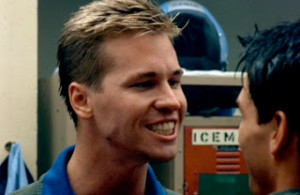
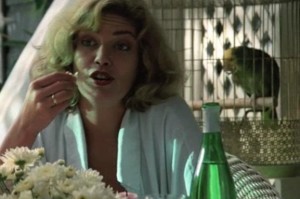
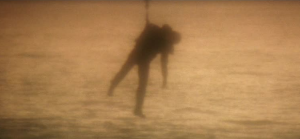
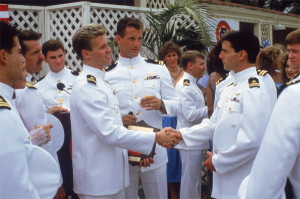
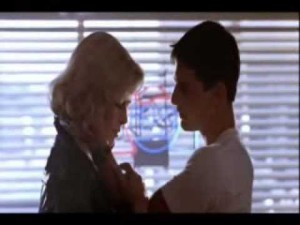


Great article, thanks.
I get how Top Gun follows Campbell’s monomyth structure, but how does The Odyssey?
Not my movie, but you’ve convinced me to go from having watched it once to twice.
Nice analysis. Though the movie makes a lot more sense if you see Iceman as the Protaganist and Maverick as the anti-hero.
I have that movie I got it last weekend and as soon as I got home I put it in my Xbox and watched it and when it was completely over I said to myself that that was the BEST damn movie I have EVER SEEN in my ENTIRE LIFE
I set myself a challenge to watch it 100 times and succeeded last December. I love it so much. Best top gun analysis I have ever read, well done :)
Thanks for your opinions of the movie because me my friend and my sister are obsessed with it and I have only watched it twice in my life ( this year!) I have always wanted to know what others thought about it!
Very interesting thoughts on my favorite movie of all time (and this is coming from a Navy Vet of that era).
I initially loved the movie from an aviation point of view. Now, I have a completely different perspective thanks to your post.
Very nice analysis. I love top gun with a passion. Really appreciate the depth of understanding you have provided. The full cycle Maverick makes is one we all pursue, battling our own demons, character flaws and quest to become complete. Thank you so much…
This is one of my favorite movies. Thank you for an amazing breakdown’
Nice article. I wore my VHS tape out watching this movie as a child. I saw it 5 times in the theater. I’ve seen it countless times and still watch it happily every chance I get. My question is, “How do you feel knowing the sequel is coming this year?” Excited for sure but any other feelings?
Pingback: We Have a Hop to Take | et tu, Bluto?